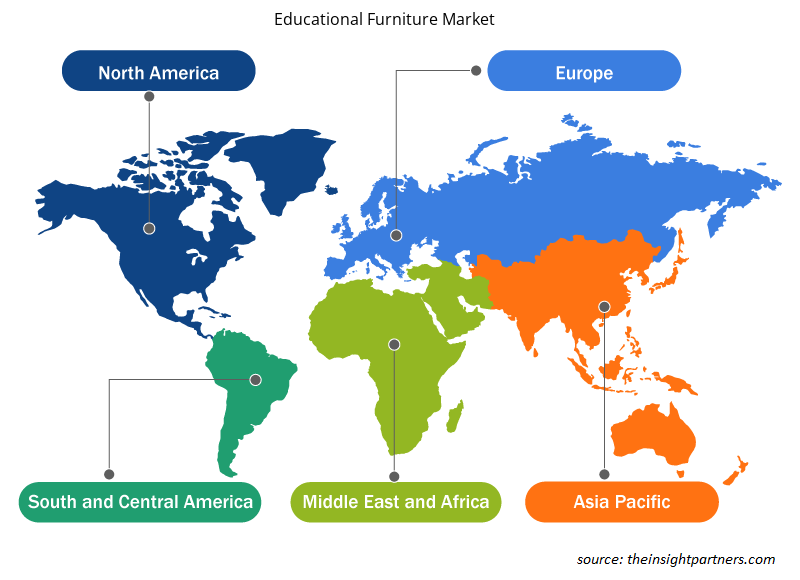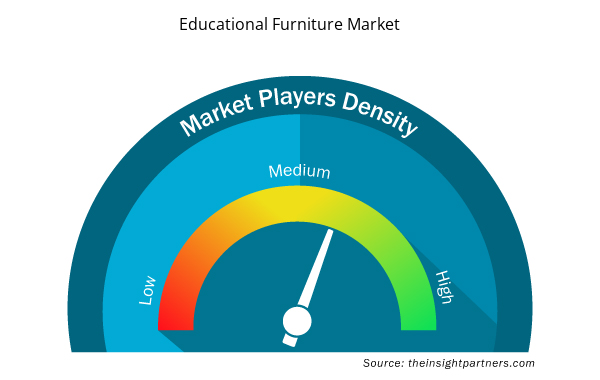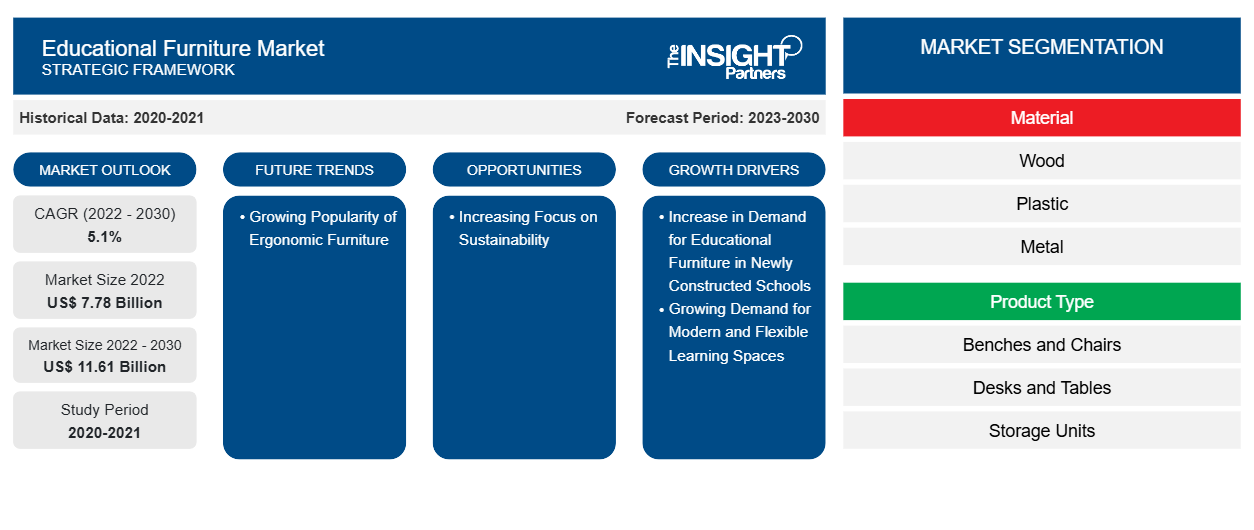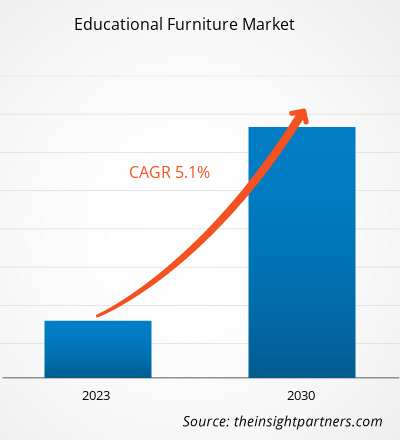[تقرير بحثي] من المتوقع أن ينمو حجم سوق الأثاث التعليمي من 7،783.45 مليون دولار أمريكي في عام 2022 إلى 11،611.64 مليون دولار أمريكي بحلول عام 2030؛ ومن المتوقع أن يسجل السوق معدل نمو سنوي مركب بنسبة 5.1٪ من عام 2022 إلى عام 2030.
رؤى السوق ووجهة نظر المحلل:
يشمل الأثاث التعليمي المكاتب والكراسي والسبورة البيضاء والخزائن وخزائن التخزين ومكاتب الخزائن. يعد الطلب المتزايد على تصميمات الأثاث المريحة لضمان الوضعية المناسبة للأطفال أحد العوامل الرئيسية التي تدفع الطلب على الأثاث التعليمي الحديث في المدارس الابتدائية. إن الاتجاه المتزايد للمدارس الصغيرة، وخاصة بعد الوباء، يدفع الطلب على الأثاث التعليمي المرن. توفر المدارس الصغيرة بيئات تعليمية مخصصة نظرًا لحجم فصولها الأصغر. تتطلب هذه المدارس أثاثًا مرنًا مثل الطاولات المستديرة والمقاعد والكراسي ذات المقاعد الناعمة والمكاتب القابلة للتعديل لاستيعاب العمل الفردي والمشاريع الجماعية والأنشطة التفاعلية للمجموعات الصغيرة التي تعزز التعلم السهل. علاوة على ذلك، فإن التركيز المتزايد على الجماليات يدفع الطلب على الأثاث الأنيق والمتين الذي يخلق مساحات تعليمية مريحة تحافظ على تركيز الطلاب. هذه العوامل تدفع بشكل كبير نمو سوق الأثاث التعليمي.
محركات النمو والتحديات:
تسعى المدارس والجامعات إلى العمل بحساسية أكبر تجاه البيئة؛ وبالتالي، يتزايد الطلب على الأثاث التعليمي المستدام. وتنمو الفصول الدراسية الخضراء ومبادرات "الانتقال إلى اللون الأخضر" على مستوى المدرسة حيث يشجع المعلمون الطلاب على تبني القيم الداعمة للسلوك الصديق للبيئة. وتحظى منتجات التخزين والكراسي والمكاتب المستدامة بتفضيل واسع النطاق في الفصول الدراسية في جميع أنحاء العالم. يتم تصنيع منتجات الأثاث هذه باستخدام مواد صديقة للبيئة مثل البولي بروبلين أو الأخشاب المتجددة أو الفولاذ، والتي تلبي معايير الانبعاثات الإلزامية للموافقة عليها؛ وعلاوة على ذلك، فهي مصممة للحفاظ على جودة الهواء الداخلي.
إن استخدام المواد المستدامة في تصنيع الأثاث يسمح أيضًا للمصنعين بإعادة تدوير نفايات المنتج، وبالتالي منع ترسب النفايات في مكبات النفايات. على سبيل المثال، تستخدم شركة Paragon Furniture Inc. الألياف المعاد تدويرها أو المستردة لتصنيع منتجاتها الخشبية. تشجع حكومات مختلف البلدان الشركات على تقديم منتجات تعزز البناء المستدام للمدارس. وبالمثل، يشجع نظام تصنيف المباني الخضراء ( LEED ) التابع لمجلس المباني الخضراء في الولايات المتحدة بناء مرافق مستدامة وعالية الأداء، وتبني الأثاث المستدام في المدارس وغيرها من المرافق التعليمية. ومن المرجح أن يؤدي ارتفاع عدد مثل هذه المبادرات لتعزيز البنية التحتية المستدامة إلى خلق فرص مربحة لنمو سوق الأثاث التعليمي في السنوات القادمة.
قم بتخصيص هذا التقرير ليناسب متطلباتك
ستحصل على تخصيص لأي تقرير - مجانًا - بما في ذلك أجزاء من هذا التقرير، أو تحليل على مستوى الدولة، وحزمة بيانات Excel، بالإضافة إلى الاستفادة من العروض والخصومات الرائعة للشركات الناشئة والجامعات
- احصل على أهم اتجاهات السوق الرئيسية لهذا التقرير.ستتضمن هذه العينة المجانية تحليلاً للبيانات، بدءًا من اتجاهات السوق وحتى التقديرات والتوقعات.
تقسيم التقرير ونطاقه:
"سوق الأثاث التعليمي العالمي" مقسم على أساس المادة ونوع المنتج والاستخدام النهائي والجغرافيا. بناءً على المادة، يتم تقسيم سوق الأثاث التعليمي إلى خشب وبلاستيك ومعادن وغيرها. حسب نوع المنتج، يتم تقسيم السوق إلى مقاعد وكراسي ومكاتب وطاولات ووحدات تخزين وغيرها. من حيث الاستخدام النهائي، يتم تصنيف السوق إلى مؤسسي وسكني. يتم تقسيم القطاع المؤسسي إلى مدرسة ابتدائية ومدرسة ثانوية وتعليم عالي. جغرافيًا، يتم تقسيم سوق الأثاث التعليمي إلى أمريكا الشمالية (الولايات المتحدة وكندا والمكسيك) وأوروبا (ألمانيا وفرنسا وإيطاليا والمملكة المتحدة وروسيا وبقية أوروبا) وآسيا والمحيط الهادئ (أستراليا والصين واليابان والهند وكوريا الجنوبية وبقية آسيا والمحيط الهادئ) والشرق الأوسط وأفريقيا (جنوب أفريقيا والمملكة العربية السعودية والإمارات العربية المتحدة وبقية الشرق الأوسط وأفريقيا) وأمريكا الجنوبية والوسطى (البرازيل والأرجنتين وبقية أمريكا الجنوبية والوسطى)
التحليل القطاعي
بناءً على المواد، يتم تقسيم سوق الأثاث التعليمي إلى الخشب والبلاستيك والمعادن وغيرها. في عام 2021، احتل قطاع الخشب أكبر حصة في السوق. يعد الأثاث الخشبي من بين الأثاث الأكثر شعبية على مستوى العالم، نظرًا لطبيعته المتينة ومنخفضة الصيانة مقارنة بالمواد الأخرى. بالإضافة إلى ذلك، يعد الأثاث الخشبي أحد أكثر الحلول الصديقة للبيئة والمستدامة للغاية مقارنة بالبلاستيك أو المواد المصنعة الأخرى. نظرًا للطلب المرتفع عليه بين المستهلكين، يعد الخشب تقليديًا المادة الأكثر تفضيلاً لإنتاج الأثاث.
من حيث الاستخدام النهائي، احتل القطاع المؤسسي الحصة الأكبر في عام 2022. عزز التحول الرقمي لقطاع التعليم الطلب على الأثاث الذي يلبي متطلبات التعلم الرقمي. تستثمر الكليات والجامعات بشكل متزايد في الأثاث الذي يمكنه استيعاب أجهزة الكمبيوتر المحمولة والأجهزة اللوحية والكتب المدرسية الرقمية. تستثمر هذه المعاهد أيضًا في الأثاث الجمالي للمناطق ذات الرؤية العالية مثل المكتبات والكافيتريات والمختبرات وقاعات المؤتمرات لجذب الطلاب وأعضاء هيئة التدريس وتحسين بيئة التعلم. يتزايد عدد الطلاب المسجلين في الكليات والجامعات والمدارس بمرور الوقت بسبب الأهمية المتزايدة للتعليم الابتدائي والعالي في البلدان المتقدمة والنامية في جميع أنحاء العالم. وفقًا للمركز الوطني لإحصاءات التعليم، في عام 2021، التحق حوالي 19 مليون طالب في الولايات المتحدة بالكليات والجامعات. مع زيادة عدد الطلاب المسجلين، هناك حاجة متزايدة إلى أثاث تعليمي حديث ومصمم هندسيًا. هذا العامل يدفع بشكل كبير نمو سوق الأثاث التعليمي.
التحليل الإقليمي:
بناءً على الجغرافيا، ينقسم سوق الأثاث التعليمي إلى خمس مناطق رئيسية: أمريكا الشمالية وأوروبا وآسيا والمحيط الهادئ وأمريكا الجنوبية والوسطى والشرق الأوسط وأفريقيا. هيمنت أمريكا الشمالية على سوق الأثاث التعليمي العالمي، والتي بلغت قيمتها 3493.99 مليون دولار أمريكي في عام 2022. أوروبا هي المساهم الرئيسي الثاني، حيث تمتلك حصة تبلغ حوالي 24٪ من السوق العالمية. بالإضافة إلى ذلك، من المتوقع أن تنمو منطقة آسيا والمحيط الهادئ بشكل كبير بمعدل نمو سنوي مركب يتراوح بين 5 و 6٪ خلال فترة التوقعات. الولايات المتحدة هي مساهم رئيسي في السوق الإقليمية، تليها كندا والمكسيك على التوالي. تعمل المؤسسات التعليمية في أمريكا الشمالية على ترقية مواردها الحالية وشراء أثاث مبتكر. تساهم سياسات التصنيع والتجارة الفعالة أيضًا في نمو سوق الأثاث التعليمي. بالإضافة إلى ذلك، يكتسب الأثاث المدرسي المصمم هندسيًا لمنع المشكلات الصحية عند الأطفال، وخاصة الناشئة عن الوضعية غير الصحيحة، قوة جذب كبيرة في هذه المنطقة. وتشهد الولايات المتحدة حضورًا لكبار مصنعي الأثاث التعليمي، وهي Fleetwood Furniture وHerman Miller Inc وSteelcase Inc. وعلاوة على ذلك، تعد Simplova وInstitutional Furniture Ltd وRJH Solutions وCDI Spaces من بين مصنعي وموردي الأثاث التعليمي العاملين في كندا. ووفقًا لتقرير البنية التحتية لعام 2021 الذي نشرته الجمعية الأمريكية للمهندسين المدنيين، يوجد حوالي 84000 مدرسة عامة تضم حوالي 100000 مبنى في الولايات المتحدة، ومن المتوقع أن يبلغ عدد الطلاب المسجلين 56.8 مليون بحلول عام 2026. وبالتالي، من المتوقع أن تؤدي الزيادة في عدد المدارس والميل نحو الأثاث الحديث والمريح ووجود مصنعي الأثاث التعليمي إلى تعزيز سوق الأثاث التعليمي في أمريكا الشمالية خلال فترة التوقعات.
تطورات الصناعة والفرص المستقبلية:
فيما يلي قائمة بالمبادرات المختلفة التي اتخذها اللاعبون الرئيسيون العاملون في سوق الأثاث التعليمي:
- في عام 2022، استحوذت شركة AFC Furniture Solutions على شركة Wipro Enterprises، التي تصمم وتمتلك علامات تجارية مثل Xbench وVibrant وLivo.
- في عام 2023، أعلنت شركة Smith System وشركتها الأم، Steelcase، عن تعيين ستة شركاء جدد من التجار الرئيسيين.
رؤى إقليمية حول سوق الأثاث التعليمي
لقد قام المحللون في Insight Partners بشرح الاتجاهات والعوامل الإقليمية المؤثرة على سوق الأثاث التعليمي طوال فترة التوقعات بشكل شامل. يناقش هذا القسم أيضًا قطاعات سوق الأثاث التعليمي والجغرافيا في جميع أنحاء أمريكا الشمالية وأوروبا ومنطقة آسيا والمحيط الهادئ والشرق الأوسط وأفريقيا وأمريكا الجنوبية والوسطى.

- احصل على البيانات الإقليمية المحددة لسوق الأثاث التعليمي
نطاق تقرير سوق الأثاث التعليمي
| سمة التقرير | تفاصيل |
|---|---|
| حجم السوق في عام 2022 | 7.78 مليار دولار أمريكي |
| حجم السوق بحلول عام 2030 | 11.61 مليار دولار أمريكي |
| معدل النمو السنوي المركب العالمي (2022 - 2030) | 5.1% |
| البيانات التاريخية | 2020-2021 |
| فترة التنبؤ | 2023-2030 |
| القطاعات المغطاة | حسب المادة
|
| المناطق والدول المغطاة | أمريكا الشمالية
|
| قادة السوق وملفات تعريف الشركات الرئيسية |
|
كثافة اللاعبين في سوق الأثاث التعليمي: فهم تأثيرها على ديناميكيات الأعمال
يشهد سوق الأثاث التعليمي نموًا سريعًا، مدفوعًا بالطلب المتزايد من المستخدم النهائي بسبب عوامل مثل تفضيلات المستهلك المتطورة والتقدم التكنولوجي والوعي المتزايد بفوائد المنتج. ومع ارتفاع الطلب، تعمل الشركات على توسيع عروضها والابتكار لتلبية احتياجات المستهلكين والاستفادة من الاتجاهات الناشئة، مما يؤدي إلى زيادة نمو السوق.
تشير كثافة اللاعبين في السوق إلى توزيع الشركات أو المؤسسات العاملة في سوق أو صناعة معينة. وهي تشير إلى عدد المنافسين (اللاعبين في السوق) الموجودين في مساحة سوق معينة نسبة إلى حجمها أو قيمتها السوقية الإجمالية.
الشركات الرئيسية العاملة في سوق الأثاث التعليمي هي:
- شركة AFC لحلول الأثاث المحدودة
- مجموعة فليتوود المحدودة
- منتجات سكولار كرافت المحدودة
- شركة سميث سيستمز للتصنيع
- شركة نول
إخلاء المسؤولية : الشركات المذكورة أعلاه ليست مرتبة بأي ترتيب معين.

- احصل على نظرة عامة على أهم اللاعبين الرئيسيين في سوق الأثاث التعليمي
تأثير كوفيد-19:
خلال المرحلة الأولية من جائحة كوفيد-19، أدى تنفيذ قيود الإغلاق وإغلاق وحدات التصنيع إلى نقص الإنتاج، مما أدى إلى خلق فجوة بين العرض والطلب. وقد تعطلت ربحية العديد من مصنعي الأثاث التعليمي على نطاق صغير وكبير بشكل كبير. ومع ذلك، كانت المعاهد التعليمية والمدارس تعمل عن بُعد من خلال الفصول الدراسية عبر الإنترنت، مما أدى إلى زيادة الطلب على الأثاث مثل المكاتب والكراسي في المنزل. وبسبب العمل عن بُعد في المدارس والكليات وزيادة التدريب عبر الإنترنت، كان هناك زيادة في الطلب على منتجات الأثاث التعليمي بسبب الحاجة المتزايدة إلى مقاعد مريحة في المنزل.
في عام 2021، استأنفت اقتصادات مختلفة عملياتها حيث أعلنت حكومات بلدان مختلفة عن تخفيف القيود المفروضة سابقًا، مما عزز السوق العالمية. سُمح للمصنعين بالعمل بكامل طاقتهم، مما ساعدهم على التغلب على فجوة العرض والطلب وغيرها من التداعيات. مع تطعيم العديد من مواطني العديد من البلدان بالكامل بحلول عام 2021، ركز مصنعو الأثاث التعليمي على زيادة إنتاجهم لإحياء أعمالهم. وقد أثر ذلك بشكل إيجابي على نمو سوق الأثاث التعليمي.
المنافسة والشركات الرئيسية:
أكبر 10 شركات تعمل في سوق الأثاث التعليمي العالمي هي AFC Furniture Solutions Pvt Ltd، وFleetwood Group Inc، وScholar Craft Products Inc، وSmith Systems Manufacturing Co، وKnoll Inc، وHaworth Inc، وVitra International AG، وVirco Manufacturing Corp، وOffice Line Srl، وCreaciones Falcon SLU. تركز هذه الشركات على تطوير الأثاث المبتكر بتصميمات مريحة لتلبية طلب المستهلك.
- التحليل التاريخي (سنتان)، السنة الأساسية، التوقعات (7 سنوات) مع معدل النمو السنوي المركب
- تحليل PEST و SWOT
- حجم السوق والقيمة / الحجم - عالميًا وإقليميًا وقطريًا
- الصناعة والمنافسة
- مجموعة بيانات Excel



Report Coverage
Revenue forecast, Company Analysis, Industry landscape, Growth factors, and Trends

Segment Covered
This text is related
to segments covered.

Regional Scope
North America, Europe, Asia Pacific, Middle East & Africa, South & Central America

Country Scope
This text is related
to country scope.
الأسئلة الشائعة
Increasing focus on sustainable furniture is expected to provide lucrative growth opportunities to the global educational furniture market during the forecast period.
Based on end use, the educational furniture market for institutional segment is the fastest-growing segment. The growth is attributed to the increasing adoption of education in rural and urban areas, growing school management's inclination toward adopting modern furniture, and the rising school enrollment rates. The demand for educational furniture for institutional use is expected to grow during the forecast period.
The major players operating in the global educational furniture market are Fleetwood Group Inc, Smith Systems Manufacturing Co, Haworth Inc, Office Line Srl, and Virco Manufacturing Corp, among others.
Based on the material, the wood segment accounted for the largest revenue share. Wood-based furniture is popular across the world due to its durability and elegant look compared to plastic furniture. Wood is an excellent material for designing and creating exclusive furniture widely used in educational institutes. These factors are driving its demand, hence surging the market growth.
Asia Pacific market dominated the educational furniture market and continue to be the largest segment by 2028. The largest share of Asia Pacific can be attributed to its increased focus on education across urban and rural areas, and the implementation of mandatory primary education schemes by governments result in the construction of schools and educational institutions across this region.
The increase in demand for educational furniture in newly constructed schools, and growing demand for modern and flexible learning spaces, are some of the key driving factors for the educational furniture market.
Trends and growth analysis reports related to Consumer Goods : READ MORE..
The List of Companies - Educational Furniture Market
- AFC Furniture Solutions Pvt Ltd
- Fleetwood Group Inc
- Scholar Craft Products Inc
- Smith Systems Manufacturing Co
- Knoll Inc
- Haworth Inc
- Vitra International AG
- Virco Manufacturing Corp
- Office Line Srl
- Creaciones Falcon SLU
The Insight Partners performs research in 4 major stages: Data Collection & Secondary Research, Primary Research, Data Analysis and Data Triangulation & Final Review.
- Data Collection and Secondary Research:
As a market research and consulting firm operating from a decade, we have published and advised several client across the globe. First step for any study will start with an assessment of currently available data and insights from existing reports. Further, historical and current market information is collected from Investor Presentations, Annual Reports, SEC Filings, etc., and other information related to company’s performance and market positioning are gathered from Paid Databases (Factiva, Hoovers, and Reuters) and various other publications available in public domain.
Several associations trade associates, technical forums, institutes, societies and organization are accessed to gain technical as well as market related insights through their publications such as research papers, blogs and press releases related to the studies are referred to get cues about the market. Further, white papers, journals, magazines, and other news articles published in last 3 years are scrutinized and analyzed to understand the current market trends.
- Primary Research:
The primarily interview analysis comprise of data obtained from industry participants interview and answers to survey questions gathered by in-house primary team.
For primary research, interviews are conducted with industry experts/CEOs/Marketing Managers/VPs/Subject Matter Experts from both demand and supply side to get a 360-degree view of the market. The primary team conducts several interviews based on the complexity of the markets to understand the various market trends and dynamics which makes research more credible and precise.
A typical research interview fulfils the following functions:
- Provides first-hand information on the market size, market trends, growth trends, competitive landscape, and outlook
- Validates and strengthens in-house secondary research findings
- Develops the analysis team’s expertise and market understanding
Primary research involves email interactions and telephone interviews for each market, category, segment, and sub-segment across geographies. The participants who typically take part in such a process include, but are not limited to:
- Industry participants: VPs, business development managers, market intelligence managers and national sales managers
- Outside experts: Valuation experts, research analysts and key opinion leaders specializing in the electronics and semiconductor industry.
Below is the breakup of our primary respondents by company, designation, and region:

Once we receive the confirmation from primary research sources or primary respondents, we finalize the base year market estimation and forecast the data as per the macroeconomic and microeconomic factors assessed during data collection.
- Data Analysis:
Once data is validated through both secondary as well as primary respondents, we finalize the market estimations by hypothesis formulation and factor analysis at regional and country level.
- Macro-Economic Factor Analysis:
We analyse macroeconomic indicators such the gross domestic product (GDP), increase in the demand for goods and services across industries, technological advancement, regional economic growth, governmental policies, the influence of COVID-19, PEST analysis, and other aspects. This analysis aids in setting benchmarks for various nations/regions and approximating market splits. Additionally, the general trend of the aforementioned components aid in determining the market's development possibilities.
- Country Level Data:
Various factors that are especially aligned to the country are taken into account to determine the market size for a certain area and country, including the presence of vendors, such as headquarters and offices, the country's GDP, demand patterns, and industry growth. To comprehend the market dynamics for the nation, a number of growth variables, inhibitors, application areas, and current market trends are researched. The aforementioned elements aid in determining the country's overall market's growth potential.
- Company Profile:
The “Table of Contents” is formulated by listing and analyzing more than 25 - 30 companies operating in the market ecosystem across geographies. However, we profile only 10 companies as a standard practice in our syndicate reports. These 10 companies comprise leading, emerging, and regional players. Nonetheless, our analysis is not restricted to the 10 listed companies, we also analyze other companies present in the market to develop a holistic view and understand the prevailing trends. The “Company Profiles” section in the report covers key facts, business description, products & services, financial information, SWOT analysis, and key developments. The financial information presented is extracted from the annual reports and official documents of the publicly listed companies. Upon collecting the information for the sections of respective companies, we verify them via various primary sources and then compile the data in respective company profiles. The company level information helps us in deriving the base number as well as in forecasting the market size.
- Developing Base Number:
Aggregation of sales statistics (2020-2022) and macro-economic factor, and other secondary and primary research insights are utilized to arrive at base number and related market shares for 2022. The data gaps are identified in this step and relevant market data is analyzed, collected from paid primary interviews or databases. On finalizing the base year market size, forecasts are developed on the basis of macro-economic, industry and market growth factors and company level analysis.
- Data Triangulation and Final Review:
The market findings and base year market size calculations are validated from supply as well as demand side. Demand side validations are based on macro-economic factor analysis and benchmarks for respective regions and countries. In case of supply side validations, revenues of major companies are estimated (in case not available) based on industry benchmark, approximate number of employees, product portfolio, and primary interviews revenues are gathered. Further revenue from target product/service segment is assessed to avoid overshooting of market statistics. In case of heavy deviations between supply and demand side values, all thes steps are repeated to achieve synchronization.
We follow an iterative model, wherein we share our research findings with Subject Matter Experts (SME’s) and Key Opinion Leaders (KOLs) until consensus view of the market is not formulated – this model negates any drastic deviation in the opinions of experts. Only validated and universally acceptable research findings are quoted in our reports.
We have important check points that we use to validate our research findings – which we call – data triangulation, where we validate the information, we generate from secondary sources with primary interviews and then we re-validate with our internal data bases and Subject matter experts. This comprehensive model enables us to deliver high quality, reliable data in shortest possible time.


 احصل على عينة مجانية لهذا التقرير
احصل على عينة مجانية لهذا التقرير